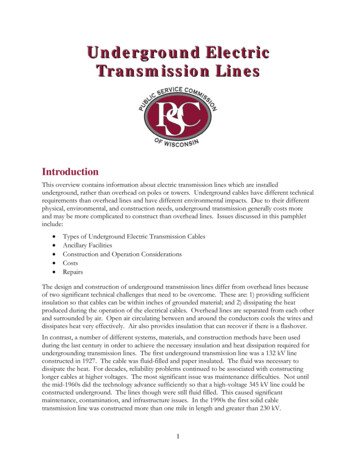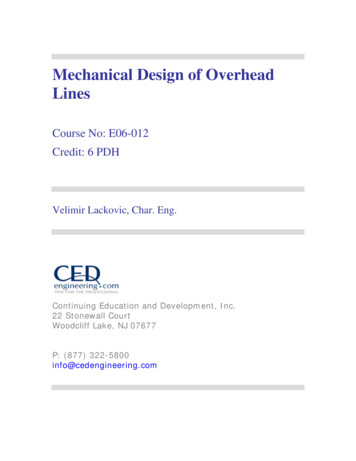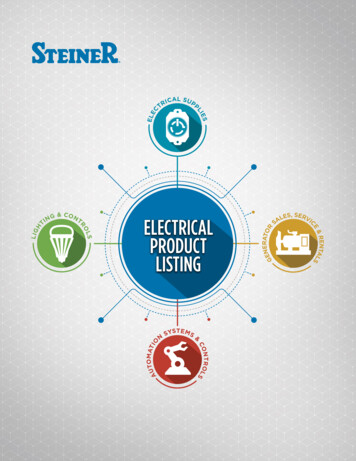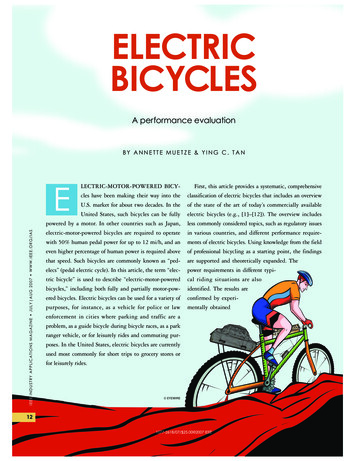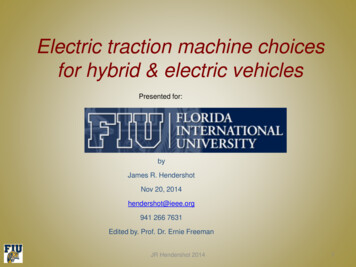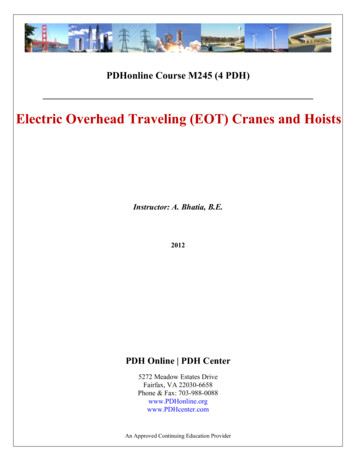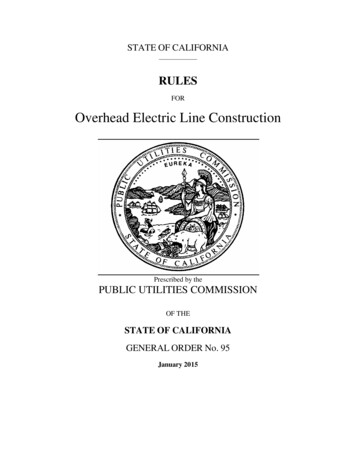
Transcription
STATE OF CALIFORNIARULESFOROverhead Electric Line ConstructionPrescribed by thePUBLIC UTILITIES COMMISSIONOF THESTATE OF CALIFORNIAGENERAL ORDER No. 95January 2015
(This Page Intentionally Left Blank)
ContentsIntroductoryPageContentsiList of TablesiiiChange ListvPrefaceixDecision No 34884, Case No. 4324(Ordering Adoption of General Order No. 95)xiSectionsPageI.General ProvisionsI-1II.Definition of Terms as Used in the Rules of This OrderII-1III. Requirements for All LinesIII-1IV.Strength Requirements for All Classes of LinesIV-1V.Detailed Construction Requirements for Supply Lines(Class H, L and T Circuits)VI.Detailed Construction Requirements for Tower Lines andExtra High Voltage Lines (Class E Circuits)VII. Detailed Construction Requirements for Trolley and Electric Railway Contactand Feeder Conductors and Their Supporting Messengers, Span Wires, Etc.(Class T Circuits)VIII. Detailed Construction Requirements for Communication Lines(Class C Circuits)V-1VI-1VII-1VIII-1IX.Joint Poles or Poles Jointly UsedIX-1X.Supply and Communication Lines in Line Crossings or ConflictsX-1XI.Supply Lines or Communication Lines Crossing Over RailroadsXI-1iJanuary 2015
AppendicesPageAppendix ALoading DistrictsA-1Appendix BMechanical and Loading Data for ConductorsB-1Appendix CConductor SagsC-1Appendix DTypical Communication Line ConstructionD-1Appendix EClearance of Poles, Towers and Structures fromRailroad TracksGuidelines to Rule 35E-1E-2Appendix FTypical ProblemsF-1Appendix GTypical Illustrative Diagrams of RulesG-1Appendix HSettlement AgreementH-1IndexiiJanuary 2015
TablesTableRuleTitle137Basic Minimum Allowable Vertical Clearances of Wires Above Railroads Thoroughfares,Ground or Water Surfaces, etc.238Basic Minimum Allowable Clearance of Wires from Other Wires at Crossings, etc.2–A39Minimum Clearances of Wires From Signs Mounted on Buildings and Isolated Structures342Grades of Construction444.1Minimum Safety Factors548.1Wood Strengths649.1–CPole Setting Depths of Wood Poles749.3–BSize and Material of Tie Wires849.4–BMinimum Conductor Sizes (150–Foot Spans or Less)949.6–BMinimum Size and Strength of Guys Crossing Over Class E, H, L, T, or C Circuits1054.8–B4bMinimum Allowable Clearance of Service Drops of 0 - 750 Volts from Buildings1154.8–C1Minimum Radial Clearance Between Supply Service Drop Conductors and CommunicationLine Conductors Not on Messengers1255.3–CInsulator Flashover Voltages1356.8–CGuy Insulator Flashover Voltages58.158.1–BUnprotected Bus and Lead Wire Clearances58.258.1–BClearances of Ungrounded Cases from Line Conductors14Table 14 deleted November 6, 1992 by Resolution SU–15.1584.8–D1Minimum Radial Clearance Between Communications Service Drops and Line Conductors1686.8–CGuy Insulator Flashover Voltages17App. BCopper Wire - Bare, Solid - Characteristics and Loading18App. BCopper Wire - Bare, Stranded and Solid - Characteristics and Loading19App. BCopper Wire - Stranded and Solid, Double Braid Weatherproof - Characteristics andLoading20App. BCopper Wire - Stranded and Solid, Triple Braid Weatherproof - Characteristics and Loading21App. BGalvanized Steel and Iron Wire - Bare, Solid - Characteristics and Loading22App. BCopper Covered Steel, Strand, Solid and Composite - Characteristics and Loading23App. BAluminum Cable Steel Reinforced - Bare - Characteristics and Loading24App. BMechanical Characteristics of Galvanized Steel Strand25App. CStringing Sags for Communication Conductors in Grade F ConstructionTables 26 & 27 were deleted by Decision No. 0501030 an January 13, 2005 byiiiJanuary 2015
(This Page Intentionally Left Blank)ivJanuary 2015
General Order Number 95Public Utilities Commission of the State of CaliforniaRules for Overhead Electric Line ConstructionAdopted December 23, 1941Effective July 1, 1942Decision No. 34884, Case No. 4324Change list— The following is a list of Decisions and Resolutions which authorize statewide general changesto this Order, applicable to all operators of overhead lines.Decision or ResolutionNo.Date EffectiveRules Herein Revised, Deleted or AddedDecision No. 41134February 1, 194836., 37., Table 1, 54.5–B1, 74.4–B1, 77.4–AResolution No. E–756May 29, 195149.4–C7a, 54.8–AResolution No. E–762October 2, 195154.8–B4aResolution No. E–862September 14, 195451.6–A, 52.4–AResolution No. E–949February 11, 195754.9–C1, 54.9–C2, 54.9–DResolution No. E–1011February 3, 1959103.1–AResolution No. E–1030June 8, 195956.6–DResolution No. E–1068July 1, 196039, Table 2–AResolution No. E–1088May 1, 196122.2, 54.6–C, 84.6–BResolution No. E–1109January 2, 196222.10, 31.3,37, Table 1, 54.4–A4, 54.8–B5, 54.10,56.4–A3, 84.4–A5, 84.8–C5, 86.4–A3, 91.3Decision No. 66707February 7, 196420.6, 20.8–D, 21.10, 22.0–D, 31.5, 37, Table 1, 38,Table 2, 54.4–C4b, 54.4–C4c, 54.4D–2, 54.4–D6b,54.4–D6c, 54.6–D, 54.6–E, 54.6–F, 54.7–A, 55.3–D,58.3–C3, 58.3–D, 91.1, Appendix G, Figs. 87, 88Decision No. 67820September 15, 196456.9, 86.9Decision No. 68835April 26, 196548.1, Table 5Decision No. 69071June 7, 196522.2–C, 54.6–C, 54.6–D, 54.6–E, 54.8–C2, 84.6–D,84.6–E, 84.8–D2, Appendix G Fig 61.Decision No. 70489March 29, 196620.7, 32.4–A2, 32.4–C1, 33.1, 33.3–B, 37, Table 1,51.6–A, 52.4–B2c, 52.4–B2e, 52.4–B3, 54.4–A1,54.4–A2, 54.4–C4c, 54.4–D2, 54.4–D8b, 54.4–H2,54.4–I, 54.6–F, 54.7–A4, 54.9–E1, 54.9–E4, 54.4–E,56.6–A, 56.6–B, 56.6–D, 56.6–E, 58.3–B3e, 58.3–E,58.4–B–3b, 59.2, 59.3–B, Table 14, 59.3–D, 59.4–A2, 59.4–B1, 59.4–C, 86.4–E, 86.6–A, 86.6–B, 86.6–C, 86.6–D, 86.7–A1, 86.7–A2, 89.2–A, 89.3, 92.1–A,App. G Figs. 6, 9, 20, 21, 22, 33, 43, 45, 46, 47, 52,87.vJanuary 2015
Decision No. 71009July 26, 196622.0–E, 22.8, 44.1, Table 4, 48.6, 49.1–A, 54.6–B,54.6–F.Decision No. 71094August 9, 196620.7, 32.4–A2, 32.4–C1, 33.1, 33.3–B, 37, Table 1,51.6–A, 52.4–B2c, 52.4–B2e, 52.4–B3, 54.4–A1,54.4–A2a, 54.4–A2b, 54.4–C4c, 54.4–D2, 54.4–D8b,54.4–H2, 54.4–I, 54.6–F, 54.7–A4, 54.9–E1, 54.9–E4, 56.4–E, 56.6–A, 56.6–B, 56.6–D, 56.6–E, 58.3–B3e, 58.3–E, 58.4–B3b, 59.2, 59.3–B, Table 14,59.3–D, 59.4–A2, 59.4–B1, 59.4–C, 86.4–E, 86.6–A,86.6–B, 86.6–C, 86.6–D, 86.7–A1, 86.7–A2, 89.2–A,89.3, 92.1–A, App. G Figs. 6, 9, 20, 21, 22, 33, 43,45, 46, 47, 52, 87.Decision No. 72681July 17, 196779.1, 79.2, 79.3, 79.4, 79.5, 79.6Decision No. 72984September 18, 196712.3, 22.2–B, 37, Table 1, 38, Table 2, 49.4–C7a,52.7–D, 53.4–A2, 53.4–A3, 53.4–A3a, 54.4–D7b,54.6–F, 54.7–A2, 54.7–A3b, 54.7–A4, 54.8–B4b,54.9–E1, 58.3–B7, 58.4–B6, 58.5–D, 92.2Decision No. 73455January 6, 196816, 20.8, 20.9, 20.10, 21.5, 21.7–D, 22.2–D, 44.1,Table 4, 49.5–D, 54.4–C4b, 54.4–D6b, 54.6–A,,54.6–C, 54.6–D, 54.6–H, 54.7–A, 54.8–B4a, 54.8–B4b, Table 10, 54.11, 55.3–B, 56.6–D, 84.6–F.Decision No. 73722February 14, 196856.4–C4, 86.4–C4.Decision No. 73813March 30, 196820.5–D, 20.8, 21.7–C, 33.1, 37, Table 1, 38, Table 2,39, Table 2–A, 42, Table 3, 44, 44.1, Table 4, 48.2,49.1–A, 49.6–B, Table 9, 50, 51.6–A, 54.4–A1, 54.4–C2a, 54.4–C7, Section VI, 100, 103.2, 113.2Decision No. 74342July 22, 196838, Table 2, 49.3–B, Table 7, 54.4–D6b, 54.6–D6,54.8–B4b, 54.11–G, app. G Fig. 15.Decision No. 78516April 2, 197122.2–E.Decision No. 81871September 12, 197322.2–C.Decision No. 81872September 12, 197322.2–D, 54.6–E.Decision No. 82466February 13, 197444, 44.1, Table 4, 48.3–B, 49.1–A, 49.1–C, 49.2–A,49.2–B.Resolution No. E–1401July 16, 197458.3–C1c.Decision No. 83420September 11, 197438, Table 2, 58.3–C3, 59.4–A.Resolution No. E–1689June 21, 197784.6–E.Decision No. 87964October 12, 197752.4–E.Decision No. 89022June 27, 197874.4–E.Decision No. 89125August 24, 197854.11–H.viJanuary 2015
Decision No. 91030November 20, 197956.6–A, 56.6–B, 56.6–E, 56.8, Table 13, 86.4–E,86.6–A, 86.6–B, 86.6–C, 86.6–D, 86.7–A2, 86.8,Table 16, App. G Figs. 45, 46, 47 and 52.Decision No. 91186January 8, 198022.0–D, 32.3, 37, 54.4–D3, 54.8–D1, 54.10–B1,54.10–B6, 57.4–H, 74.4–D, 84.4–D4a, 84.8–E1,87.4–D5, Table 1 Case 10 and revise references (u)6,(oo), (pp), (qq), (rr) and (ss).Resolution No. E–1863February 13, 198022.2–C, 22.2–D, 54.6–C2,54.6–E, 84.6–B, 84.6–E.Resolution No. E–3076March 9, 198815, 20.10–delete, 22.2–F–add, 37, Table 1–addCases 11 & 12 and references (tt), (uu), (vv), (ww),(xx); 38, Table 2–revise heading above Case 8, addreference (pp) to Cases 8 & 9, revise Case 20, deletereference (dd); 49.2–C2, 49.3–C2, 52.7–C, 52.7–D,54.4–D7–delete, App. G, Fig. 13 & 14–delete, 54.4–D8, 54.6–E, 54.7–A, 54.8–D1, 54.10–B6, 54.10–F,54.11, 57.4–H, 83.4–add, 84.4–D4a, 84.6–E, 84.7–E,84.8–E1, 86.6–C, 87.4–D5, App. G, Figs. 39, 84 and89–revise, 92.1–B.Resolution No. SU–5May 22, 199020.6, add 21.4 & 21.5, 22.2–C, 38, 51.6, 51.6–A,52.4, 52.7–D., 54.4–C1c, 54.4–D1, 54.4–D8, 54.6–C2, 54.6–F, 54.7–A, 54.7–A3, 54.7–B2, 54.11–F,58.3–B3d, 58.3–B3e, 58.5–D, 59.7–B1, 84.7, 93.,delete App. G Figs. 15, 16, 17, 18, 19, 20, 21, 22, 23,24, 25, 26, 27, 28, 29, 30, 31, 61.Resolution No. SU–6November 21, 199020.3, 20.5, 20.8, 54.4–A4, 54.4–C4c, 54.6–C4, 54.8–B5, 56.4–A3, 56.9, 81.3, 84.4–A6, 84.4–A5, 84.8–C5,86.4–A3, 84.4–E, 84.4–C1b,84. 4–D1, 84.4–D3,84.7–A, 84.8–C4, 86.9, 87.4–C3.Resolution No. SU–10January 21, 199248, 49, Table 4, 52.7–F, 53.4, 54.4–A, 54.4–C4b,54.4–D6b, 54.8, Table 10, 54.10–D, 54.12, 56.4–A1,56.4–C2, 56.4–C3, 56.4–C4, 56.4–D, 56.4–F, 56.5,56.6–A, 56.6–D, 56.7–A, 56.7–B, 56.7–C, 56.8–A,56.8–C, 57.4–A, 57.4–B2, 57.4–F, 57.4–G, 57.5,57.7, 59.3–A, 59.3–F, 74.4–E, 77.4–B, 84.8–A, 84.8–B1, 84.8–B2, 84.8–C, 84.8–C1, 84.8–C2, 84.8–C3,84.8–D1, 92.1–F4.Resolution No. SU–15November 6, 199220.7, 20.8–G, 21.12, 22.0–F, 22.8, 34, 35, 54.4–C7,54.4–H1, 54.4–I, Figure 54–24, 54.7–B, 54.8, Table10, 54.8–G, 59.3–A, 59.3–B, Table 14 deleted, 59.3–D, 59.3–E4, 59.4–A1, 59.4–A2, 59.4–B, 59.4–C,61.6–A, 61.6–B, 61.7, 83.4, 84.4–D4a, 84.4–E, 84.4–F, 84.8–D, 84.8–E, 84.8–E1, 86, 92.1–F1, AppendixE.viiJanuary 2015
Resolution No. SU–25January 19, 199420.5–A, 20.5–B, 20.10, 20.8–E, 22.2, 23.1, 23.1–A,23.2, 23.2–A, 33.2, 38, Table 2, 49.1–C, 51.6–A,51.6–B, 52.4, 52.5, 52.7, 54.4–G, 54.4–H1, 54.6–C,54.6–D, 54.6–E, 54.6–F, 54.6–G, 54.6–H, 54.6–I,54.7–A, 54.12–F1, 54.12–F2, 56.4–C, 58.1, 58.2,58.3, 58.4, 58.5, 58.6, 70, 84.6–B, 84.6–D, 84.6–E,86.4, 86.4–A1, 91.4, 104, 114 deleted, Appendix E, AppendixG, Figures 57 through 59 deletedResolution No. SU–35September 7, 199520.5–A1Decision No. 96–09–097 September 20, 1996 35, 37 Table 1, Appendix EResolution SU–40October 9, 199620.0, 20.1, 33.3–B, 34–B, 37 Table 1, 38 Table 2,48.1, Table 5, 49.1–C, 53.4, 54.4–D8, 54.4–G, 54.6– A, 54.6–B, 54.7–A, 54.7–B, 54.9, Figures 54–13 through 54–18,Figures 54–20 through 54–23 (moved Appendix G Figures 32,33, 43 and 60 into text), 54.10, 54.11–F, 54.11–G, 54.12–F3,56.4–A1,56.4–C2, 56.9, 74.4–B2, Figure 74–2 (movedAppendix G Figures 62 and 63 into text), 83.4–A,84.4–E, 84.6–D, 84.6–E, 84.8–C4, 86.4–A1, 86.4–F,86.8–C, 86.9, 87.1, 87.4–H added, 87.7–D, 87.9,92.1–F, 92.4Decision No. 97–01–044 January 23, 199735, 37 Table 1, Appendix EDecision No. 97–10–056 October 22, 199735Decision No. 050103012.5, 12.6, 17, 20.3, 20.8-G, 20.8-H, 20.9-D 21.4,22.0-C, 22.2-A, 22.2-B, 23.3-A, 31.6, 35, 37, Table 1, Table 2,January 13, 200644.1, 44.2, 48.2, 49.1-A, 49.1-C, 49.2-E,51.6, 54.6-A, 54.6-B, 54.7-A3, 54.8 Table 10, 54.8- B3, 54.10E, 58.1, 58.2, 61, 74.4-B1, 77.4-A, 81.3-A,83.4, 84.6-D, 84.7-E, 87.10, 92, Deleted Tables 26 and 27Decision No. 0702030August 14, 200720.0, 94, Appendix HDecision No. 0810017June 29, 2009Table 2, 91.3-B, 92.1-F2, 94Decision No. 0908029August 20, 200912, 18, 19, 35, Table 1, Table 2, 44.2, 44.3Appendix E, Page 2Decision No. 1201032January 12, 201211, 18, 23, 31.1, 31.2, 35, Table 1, 44.1, 44.2, 44.3,44.4, 80.1, 91.5Appendix E, Page 2Decision No. 1306011June 27, 201380.1-A1, 80.1-BDecision No. 1402015February 5, 201442, 42-Table 3, 43, 43.1-C, 43.2-C, 44, 44.1, 44.1- Table 4,44.2, 44.3, ,45, 45.1, 46, 47, 48, 48.1, 48.1- Table 5, 48.2, 48.4, 48.5, ,48.6, 48.7, 49.1-A, 49.1- B, 49.1C, 49.2-A, 49.2-C, 49.2-E, 49.3-C2, 49.4-B - Table 8, ,49.4C5, 49.7-B, 49.7-C, 49.8, 54.10-E,54.10-G, 54.10-H, 81.3-A, 84.5, 101.2, ,111.3,January 2015viii
Decision No. 1501005January 2015January 21, 201537-Table 1, 51.7, 54.6-E, 54.9-C, 57.4-A3i, 58.1-A1,58.3-D4, 71.7, 81.6, 84.4-C2, 84.4-E, 84.4-F, 84.7,87.4, 87.7-D, Figure 84-2, Figure 84-3, Figure 84-4,Figure 84-5, 91.3-B, 91.4, Appendix G Fig 10 and Fig11.ix
PrefaceThe rules and regulations contained in this General Order embody the results ofextensive investigations and mature study. By means of development fromcommittee work in which all branches of the electric industry have taken part,these rules reflect long years of experience gained in the construction, operationand maintenance of overhead electric lines of all types. Furthermore, knowledgegained from the application of rules and regulations of this nature has generouslycontributed to the formulation of the rules contained herein.On April 22, 1911, the State Legislature passed an act (Chapter 499, Statutes of1911) which regulated the erection and maintenance of poles, wires, etc.,employed in overhead electric line construction. In 1915 the Legislature issuedChapter 600, which amended Chapter 499. The Statues of 1915 required theRailroad Commission to inspect all work affected by the provisions of the act, andto make such further additions and changes as it might deem necessary for theprotection of employees and the general public. The Railroad Commission wascharged with the duty of enforcing all provisions of the act and vested with theauthority to grant such additional time as was necessary to reconstruct lines inconformity with the Statues above referred to.On May 1, 1922, the Railroad Commission, after the many years ofadministration of the provisions of the State Statutes, issued its General OrderNo. 64 covering rules and regulations for overhead electric line construction. OnDecember 17, 1928, General Order 64–A was issued applicable to linesconstructed or reconstructed on and after that date.During the period in which General Order 64–A has had its application, theindustry has witnessed, as usual, development and manufacture of newmaterials and apparatus, use of new methods of installation andadvancement in the art generally. In the endeavor to keep the overheadline rules abreast of the times, it is the general opinion of all interestedparties that revision of the existing Order was necessary in order to reflectin the rules the progress made in the maintenance and construction ofoverhead lines, and at the same time to bring about the necessaryrevisions, that practice has shown desirable, for the protection and safetyof workmen and the public in general. As such a revision is concerned witha voluminous number of technical matters, including questions of acontroversial nature, it was deemed essential that all interested parties begiven an opportunity to freely and informally discuss any and all proposedchanges. A general committee representing all branches of the electricindustry, including representatives of labor and farm interests, wasformed, which assisted the Commission’s staff in this work. In addition,with respect to those requirements in which there was lack of agreement,all interested parties had the opportunity to present such evidence asdesired at public hearings held in this matter.xJanuary 2015
The work of preparing the revision was under the general direction of Roy A.Wehe, Gas and Electric Engineer and was assigned to Mr. S.S. Bloom, a SeniorEngineer of the engineering staff, who was assisted by Messrs. L.R. Knerr andF.E. Emerson of that staff. Special effort has been made to express in clear andconcise form the meaning of each provision contained in the rules. It isrecognized that the rules are not complete construction specifications, but theydo embody minimum requirements which are capable of definite interpretationsufficient to form the basis of working specifications for overhead electric lineconstruction. The illustrations, in Appendix G, of certain requirements are typicaland explanatory of some of the minimum requirements set forth in the rules.The present form of the order is similar to that employed in its predecessor,General Order 64–A, and has been adopted for the reasons that those concernedhave become accustomed over a period of years to the form of the latter, andfurthermore, it is believed that such form presents the subject matter clearly.The first four sections cover rules of a general nature, which are not repeated inthe various succeeding sections and direct references are made to these generalrequirements throughout the rules. Wherever possible, similar rule numbers inthe various sections cover similar subject matters. As an example of this featureof the Order, rules for “Poles, Towers and Structures” in Sections V-Supply Lines,VII — Trolley Lines, VIII — Communications Lines, IX — Joint Pole Lines, X —Line Crossings, XI — Lines Crossing Railroads, are embodied in Rules 51, 71, 81,91 101 and 111. Also, Rule 54.4–A covers rules for conductor clearances aboveground for Supply lines, while Rules 74.4–A and 84.4–A refer to similarclearances for Trolley and Communication lines.An alphabetical index is included as a ready means of reference; also a generalTable of Contents, Table of Section Contents and cross–referenced illustrations,by which various rules may be found.In conclusion the Commission desires to express its thanks to the men of theindustry who have assisted in the formulations of these rules, and who, by theircooperative effort, have cordially supported the Commission and its staff in thiswork.Railroad Commission of the State of CaliforniaBy H.G. Mathewson, SecretaryDated December 23, 1941,San Francisco, CaliforniaxiJanuary 2015
Decision No. 34884Before the Railroad Commission of theState of CaliforniaIn the matter of the investigation on the Commission’s own motion into the reasonableness of therules for overhead electric line construction prescribed by General Order No. 64–A andSupplements 1 and 2 thereto.Case Number 4324Decided December 23, 1941J.J. Deuel, for California Farm Bueau FederationJames G. Marshall, for The Pacific Telephone and Telegraph Company and Southern CaliforniaTelephone CompanyP.W. DuVal, for Pacific Gas and Electric Company, San Joaquin Light and Power Corporation andMidland Counties Public Service CorporationRandolph Karr, Julian Adams, Frank Karr and E.L.H. Bissinger, for Pacific Electric RailwayCompany.E.E. Bennett and L.T. Jackson, for Union Pacific Railroad.Ernest Irwin, for California Independent Telephone Association.I.R. Dains, S.L. Foster and Charles Wagner, for Market Street Railway.Paul Lebenbaum, for Southern Pacific Company, San Diego and Arizona Eastern Railroad,Northwestern Pacific Railroad, Petaluma and Santa Rosa Railroad, Stockton ElectricRailway and Visalia Electric Railway Company.A.C. Putnam, for Nevada–California Electric Corporation.L.M. Perrin, for Public Utilities Commission of San Francisco, Municipal Railway of San Franciscoand Hetch Hetchy Water Supply.C.E. Fletcher, for Sierra Pacific Power Company, Reno, Nevada.F.A. Gift, for Western Union Telegraph Company.G.E. Jenner, for San Diego Gas and Electric Company.G.C. Larkin and W.E. Row, for Southern California Edison Company, Ltd.M.O. Bolser and A.L. Williams, for Bureau of Power and Light, Los Angeles.A.A. Smith, for Postal Telegraph–Cable Company.M.A. deLew, for Tidewater Associated Oil Company and their Subsidiaries and also for Industrialand Manufacturers of California.H.F. Neill, for Sacramento Northern Railway.W.H. Evans, for Sacramento Northern Railway Company and Tidewater Southern RailroadCompany and Central California Traction Company.xiiJanuary 2015
C.W. Carpenter, for Western Pacific Railroad Company.George E. Kimball, for Industrial Accident Commission of the State of California.L.B. Yeager, for Los Angeles Railway Corporation.Donohue, Richards and Hamlin, for Key System and East Bay Transit Company.C.H. Rohrer, F.W. Bartholomew and J.C. Macdonald, for International Brotherhood of ElectricalWorkers and Electrical Workers State Association.L.H. Anderson, for City of Palo Alto and California Municipal Utilities Association.A.W. Cartmell, for the City of Pasadena.G.E. Bishop, for Coast Counties Gas and Electric Company.James A. Graham, for Department of Electricity, San Francisco.C.E. Plummer, for Modesto Irrigation District.Elbert E. Disck, for City of Redding.C.R. Austin, for California Water and Telephone Company.Arthur G. James, for City of Palo Alto.Riley, CommissionerxiiiJanuary 2015
OpinionThe present investigation, instituted by the Commission upon its own motion, is an inquiry intothe reasonableness of the rules governing the construction of overhead electric supply andcommunication lines, as contained in General Order No. 64–A, effective March 1, 1929, and intwo supplements to that General Order which were issued in 1932 and 1934.1 Revision of therules appears desirable as many changes have occurred since their adoptions, improvementshave been made in the art of constructing lines and in the equipment used; supplementalmodifications of the rules have been made and much experience has been gained in theirapplication. At the initial hearing in this matter of June 7, 1938, a General Committeerepresenting the various interested parties was formed to discuss and study the changes to bemade in the rules and to assist the members of the Commission’s staff in the redrafting. Duringthe succeeding period of three years, members of this General Committee 2 participated in 32meetings, in which representatives of all interested parties took part, with the result that alloperators of electric supply and communication lines of the various classes were afforded theopportunity of proposing, discussing and aiding in the drafting of new and changed provisions fora revised order. Thereafter, members of the Commission’s staff prepared revised rules, in theform of a suggested general order, which were the subject of an extended (four days) meeting ofthe General Committee. After making some changes, this suggested general order was presentedin evidence by members of the Commission’s staff, at public hearings held on June 23, 24 and 25,1941. Some objections and new recommendations were made by interested parties, followingwhich further changes were made and offered in evidence at a public hearing held on September17, 1941, at which time the matter was submitted for decision.1 1 Statutes 1911, chapter 499, prescribed certain regulations for the erection, use and maintenance of electric poles, wires, cables and appliances.That statute provided that it should take effect six months from the date of its passage, insofar as it related to new work, and allowed five years inwhich to reconstruct all then existing work and construction so as to comply with its provisions. In 1915 the Commission was empowered to grantextensions of time within which to reconstruct existing lines. (Statutes 1915, chapter 600, L. A. G. & E. Corp., 11 C.R.C.291: Re ComplianceInvestigation, 22 C.R.C. 651.) The 1915 amendment also empowered the Commission to make such further additions and changes as saidcommission may deem necessary for the purpose of safety to employees and the general public."General Order No. 64 was adopted in 1922 (21 C.R.C. 659). It embodied modifications of earlier General Order No. 26 and contained numerousrequirements, including and additive to those contained in the statute. The present General Order No. 64-A was adopted in 1928 (32 C.R.C. 524).2General Committee:S.S. Bloom, Chairman California Railroad CommissionL.R. Knerr California Railroad CommissionF.A. Gift Western Union Telegraph CompanyT.J. Fleming California Independent Telephone Assn.D.I. Cone The Pacific Telephone & Telegraph Co. and Southern California Telephone CompanyS.J. Lisberger Pacific Gas and Electric CompanyD.D. Smalley San Joaquin Light and Power Corp.* and Midland Counties Public Service Corporation*W.E. Row Southern California Edison Company LtdA.C. Putnam The Nevada-California Electric Corporation**A.L. Williams Bureau of Power and Light, Los AngelesB.F. DeLanty Municipal Utilities, PasadenaJ.J. Deuel California Farm Bureau FederationC.H. Rohrer# International Brotherhood of Electrical Workers & Electrical Workers State AssociationG.E. Kimball Industrial Accident CommissionS.L. Foster Market Street RailwayJulian Adams Pacific Electric RailwayM.A. deLew Industrials*Now Pacific Gas and Electric Company**Now Southern California Edison Company#Succeeded by F.W. Bartholomew and J.C. MacdonaldxivJanuary 2015
Rules of the character here before the Commission, for modification and revision, find a wideapplication in public utility operation and service. In these respects, the rules not only provide astandard of safety, both to the workman and to the public, but likewise materially contribute tothe standard of service rendered and also afford a means of coordination between different typesof lines, such as power and communication.Under the terms of the new general order, existing facilities, lawfully erected in accordance withearlier general orders, are permitted to be maintained according to the rules effective when suchfacilities were constructed or reconstructed, except as to certain safety factor requirementsspecified in Rule 12.2; but any lines constructed or reconstructed after the new general orderbecomes effective, must comply with the rules therein contained. In other words, the newgeneral order does not require a complete and immediate reconstruction of existing lines installedprior to its effective date. Such an order would be unreasonable to operators and to the publicalike. The new order, like its predecessors, is a part of a long–range progressive programdesigned to eventually bring all lines up to the standards required in new construction.Completion of that program is not economically feasible within a short period and, in fact, therevision of the order at this time clearly indicates that no program may be considered completeand static. There is another phase to the adoption of rules such as these, in that the rules mustnot only be practical, from a physical point of view, but likewise they must be within reasonableeconomic limits; otherwise costs to serve and consumer rates may be adversely andunreasonably affected. Having in mind these considerations, Rule 12.3 in the new general orderpermits prior construction to remain in service and provides as follows:“12.3 Lines Constructed Prior to This OrderThe requirements of this Order, other than the safety factor requirements specified inRule 12.2, do not apply to lines or portions of lines constructed or reconstructed prior tothe effective date of this Order. In all other particulars, such lines or portions of linesshall conform to the requirements of the rules in effect at the time of their constructionor reconstruction.”For reasons hereinabove indicated, the Commission is of the opinion that Rule 12.3 of the newgeneral order (there is a similar provision in General Order No. 64–A) is a reasonable andnecessary provision and that it would be unreasonable to order wholesale and immediatereconstruction of all existing overhead lines, as is sometimes urged. However, Rule 12.4 providesthat if “in its opinion, safety or public interest requires, the Commission may order reconstructionor alteration of existing lines.”The form of the new general order is similar to that of its predecessor, General Order No. 64–A.Sections I to IV, inclusive, are generally applicable to all classes of electric lines, as specified inthe detailed provisions thereof. Section V embodies rules for supply lines (including trolley systemlines); Section VI for tower lines; Section VII for trolley lines; Section VIII for communicationlines; and Section IX provides special rules for all classes of lines on joint poles, while the rules ofother sections provide the ordinary rules which apply to the several classes of lines when placedon joint poles. Furthermore, in addition to modifications of rules of General Order No. 64–A, thenew rules contain some provisions which have not appeared in any previous orders. Broadlyspeaking, the changes to be incorporated in the new order will be both more and less restrictive,according to the conditions and situations obtaining.xvJanuary 2015
The order instituting investigation states that one of the purposes of the investigation was toconsider the procedure to be followed in obtaining authority to deviate from the rules and theconditions under which such authority may be granted. In this respect Rule 15 of the new orderprovides, in substance, that the Commission will consider applications which contain a fullstatement of existing conditions, together with the reasons why authority to deviate is requestedand is believed to be justifiable. That rule also provides that, unless otherwise ordered, authorityto deviate will be limited to the particular case or the specific type of construction covered by theapplication.Three of the larger operators have requested that the new general order not be made effectiveuntil six months after promulgation, primarily because of the national defense situation. In viewof the war development and the heavy demand being placed upon the utilities, it is my opinionthat the request is reasonable and the order will provide an effective date of July 1, 1942. Irecommend the following order.xviJanuary 2015
OrderThe Commission, on its own motion, having instituted an investigation into the reasonableness ofrules governing overhead line construction, said investigation having been submitted followingthe taking of evidence at public hearings and, based upon the record and upon the findingscontained in the foregoing opinion, it is hereby further found that the rules governing overheadline construction contained in the attached General Order No. 95 are reasonable and should beadopted, andIT IS HEREBY ORDERED th
General Order Number 95 Public Utilities Commission of the State of California Rules for Overhead Electric Line Construction
